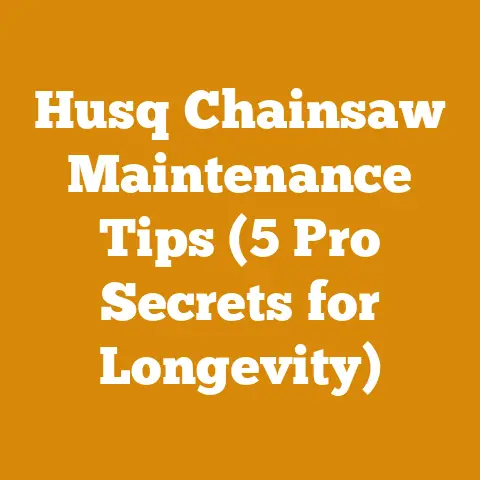Pros and Cons of Stump Grinding (5 Must-Know Arborist Tips)
Introduction: The Hidden Health Benefits of Stump Grinding
As a seasoned arborist, I’ve swung axes, wielded chainsaws, and operated just about every piece of wood processing equipment you can imagine. But believe it or not, one of the most overlooked aspects of tree care – stump grinding – offers some surprising health benefits beyond just aesthetics. Think about it: removing a tripping hazard eliminates potential falls, and eradicating a decaying stump prevents the spread of harmful fungi that can trigger allergies and respiratory issues. For me, though, it’s always been about more than just physical safety; it’s about creating a healthier, more vibrant environment for myself and my clients. And that’s why I want to share my insights on the pros and cons of stump grinding, along with five must-know arborist tips to help you make the right decision.
Pros and Cons of Stump Grinding: 5 Must-Know Arborist Tips
Stump grinding is often the final act after a tree removal, but it’s a crucial one. It’s more than just tidying up; it’s about long-term property health and safety. In this guide, I’ll break down the pros and cons of stump grinding, sharing my personal experiences and providing actionable tips to help you make an informed decision. I’ll also cover essential arborist tips to ensure the job is done safely and effectively.
What is Stump Grinding?
Stump grinding is the process of mechanically removing a tree stump using a specialized machine called a stump grinder. This machine uses a high-speed, rotating cutting wheel with tungsten carbide teeth to chip away at the stump, reducing it to small wood chips and soil. The grinding depth can vary, but typically ranges from 4 to 12 inches below ground level, enough to allow for replanting grass or other landscaping.
Why Consider Stump Grinding?
For many, the decision to grind a stump is driven by aesthetics. A decaying stump is unsightly and can detract from the overall appearance of a property. Beyond aesthetics, however, there are several other compelling reasons to consider stump grinding.
- Safety: Stumps are tripping hazards, especially for children and the elderly. They can also damage lawnmowers and other equipment.
- Pest Control: Decaying stumps attract insects like termites, ants, and beetles, which can then spread to other parts of your property, including your home.
- Disease Prevention: Some tree diseases can persist in the stump and spread to other trees and plants in the area.
- Land Use: Stumps occupy valuable space that could be used for other purposes, such as planting a garden, building a patio, or simply expanding your lawn.
- Property Value: Removing stumps can increase the value of your property by improving its appearance and usability.
The Pros of Stump Grinding: My Perspective
From my years in the field, I’ve seen firsthand the positive impact stump grinding can have. It’s not just about removing an eyesore; it’s about reclaiming your property and creating a safer, healthier environment.
- Enhanced Aesthetics: A clean, stump-free yard is simply more visually appealing. It allows for a more seamless and attractive landscape design.
- Increased Usability: Removing stumps opens up possibilities for new landscaping projects, from planting a flower garden to building a deck.
- Reduced Hazards: Eliminating tripping hazards and preventing damage to lawn equipment is a significant benefit, especially for families with children.
- Pest and Disease Control: Removing the decaying wood eliminates a breeding ground for pests and prevents the spread of tree diseases.
- Improved Property Value: A well-maintained, stump-free yard can significantly increase the value of your property.
The Cons of Stump Grinding: A Realistic View
While the benefits of stump grinding are clear, it’s important to consider the potential drawbacks. As an arborist, I believe in providing a balanced perspective, so you can make the best decision for your specific situation.
- Cost: Stump grinding can be expensive, especially for large or multiple stumps. The cost will vary depending on the size of the stump, its location, and the complexity of the job.
- Mess: Stump grinding creates a considerable amount of wood chips and soil. While most professionals will clean up the area after grinding, some cleanup may still be required.
- Potential Damage: If the stump is located near underground utilities or sprinkler systems, there is a risk of damage during the grinding process. It’s crucial to have utilities marked before starting the job.
- Noise: Stump grinders are loud machines. The grinding process can be disruptive to neighbors, especially if it takes a long time.
- Root System: While stump grinding removes the visible portion of the tree, the root system remains in the ground. Over time, the roots will decompose, but this can take several years.
Stump Grinding vs. Stump Removal: Which is Right for You?
Often, clients ask me about the difference between stump grinding and stump removal. While both methods achieve the same goal – eliminating the stump – they differ significantly in their approach and impact.
- Stump Grinding: This method grinds the stump down to a specified depth below ground level. The resulting wood chips and soil can be used to fill the hole, or they can be removed and replaced with topsoil. Stump grinding is generally less expensive and less disruptive than stump removal.
- Stump Removal: This method involves excavating the entire stump and its root system from the ground. This is a more invasive process that can cause significant damage to the surrounding landscape. Stump removal is typically only necessary if you plan to build on the site or if the stump is very large and close to a structure.
In most cases, I recommend stump grinding as the preferred method. It’s less disruptive, less expensive, and effectively eliminates the stump.
Here are five essential tips to keep in mind:
1. Get Multiple Quotes
Don’t settle for the first quote you receive. Get at least three quotes from different arborists or tree service companies. This will give you a better understanding of the average cost for stump grinding in your area and allow you to compare services and expertise.
My Experience: I’ve seen homeowners overpay significantly for stump grinding simply because they didn’t shop around. Taking the time to get multiple quotes can save you a considerable amount of money.
Actionable Advice: When requesting quotes, be sure to provide accurate information about the size and location of the stump. This will help the arborist provide a more accurate estimate.
2. Check for Underground Utilities
Before starting any stump grinding project, it’s crucial to check for underground utilities. Contact your local utility companies to have them mark the location of any buried lines. This will prevent damage to utilities and ensure the safety of the workers.
My Experience: I once worked on a project where a homeowner accidentally hit a gas line while trying to remove a small stump. Fortunately, no one was injured, but it could have been a disaster. Always prioritize safety and check for utilities before you start.
Actionable Advice: Call 811 (in the United States) before you dig. This service will notify your local utility companies, who will then mark the location of any underground lines.
3. Consider the Location of the Stump
The location of the stump can significantly impact the cost and complexity of the grinding process. Stumps located near fences, buildings, or other obstacles may require more specialized equipment and techniques.
My Experience: I once had to grind a stump that was located directly next to a brick wall. It was a tight space, and I had to use a smaller, more maneuverable stump grinder to avoid damaging the wall.
Actionable Advice: When requesting quotes, be sure to point out any obstacles or potential challenges to the arborist. This will help them assess the job accurately and provide a more realistic estimate.
4. Ask About Cleanup
Stump grinding creates a considerable amount of wood chips and soil. Be sure to ask the arborist about their cleanup procedures. Will they remove the wood chips, or will they leave them for you to dispose of? Will they fill the hole with topsoil, or will you need to do that yourself?
My Experience: I’ve seen some homeowners surprised by the amount of cleanup required after stump grinding. Be sure to clarify the cleanup process upfront to avoid any misunderstandings.
Actionable Advice: Discuss cleanup options with the arborist and choose the option that best suits your needs and budget.
5. Inquire About Insurance and Licensing
Always choose an arborist or tree service company that is properly licensed and insured. This will protect you from liability in case of accidents or damage to your property.
My Experience: I once worked with a homeowner who hired an unlicensed contractor to remove a tree. The contractor damaged the homeowner’s property, and the homeowner had no recourse because the contractor was not insured.
Actionable Advice: Ask the arborist for proof of insurance and licensing before hiring them. Check with your local licensing board to verify that the arborist is in good standing.
Understanding Stump Grinder Types and Their Applications
Different types of stump grinders are designed for different applications. Knowing the different types can help you understand the scope of the job and the equipment required.
- Walk-Behind Stump Grinders: These are the most common type of stump grinder. They are relatively small and maneuverable, making them ideal for residential properties.
- Tow-Behind Stump Grinders: These grinders are larger and more powerful than walk-behind models. They are typically used for larger stumps and commercial applications.
- Self-Propelled Stump Grinders: These grinders are equipped with their own engines and drive systems, making them easier to maneuver over rough terrain.
- Stump Grinder Attachments: Some excavators and skid steers can be fitted with stump grinder attachments. These attachments are typically used for large-scale land clearing projects.
Safety First: Essential Precautions During Stump Grinding
Safety should always be your top priority when operating a stump grinder. These machines are powerful and can be dangerous if not used properly.
- Wear Protective Gear: Always wear safety glasses, hearing protection, and gloves when operating a stump grinder.
- Clear the Area: Remove any obstacles from the area around the stump, including rocks, branches, and debris.
- Keep Bystanders Away: Keep children and pets away from the work area.
- Read the Manual: Before operating the stump grinder, read the manufacturer’s manual carefully and follow all safety instructions.
- Inspect the Machine: Before each use, inspect the stump grinder for any damage or wear.
The Environmental Impact of Stump Grinding
Stump grinding can have both positive and negative impacts on the environment. It’s important to consider these impacts when making your decision.
- Positive Impacts: Stump grinding can prevent the spread of tree diseases and reduce the use of pesticides. It can also improve soil health by incorporating wood chips into the soil.
- Negative Impacts: Stump grinding can create dust and noise pollution. It can also disrupt soil structure and harm beneficial soil organisms.
Alternatives to Stump Grinding: Exploring Other Options
While stump grinding is often the best option, there are other alternatives to consider.
- Chemical Stump Removal: This method involves applying a chemical herbicide to the stump to kill it. This can take several months or even years, and it may not be effective on all types of trees.
- Natural Decomposition: This method involves allowing the stump to decompose naturally. This can take many years, and the stump will still be a tripping hazard and a potential breeding ground for pests.
- Burning: In some areas, it may be possible to burn the stump. However, this is often prohibited due to air quality regulations and fire hazards.
Cost Breakdown: Factors Affecting Stump Grinding Prices
The cost of stump grinding can vary depending on several factors. Understanding these factors can help you budget for the project and negotiate a fair price.
- Stump Size: Larger stumps will typically cost more to grind than smaller stumps.
- Stump Location: Stumps located in difficult-to-access areas may cost more to grind.
- Stump Type: Some types of trees are harder to grind than others.
- Root System: Stumps with extensive root systems may require more time and effort to grind.
- Travel Time: Arborists may charge for travel time if the job is located far from their base of operations.
- Cleanup: The cost of cleanup can vary depending on the amount of debris and the level of service provided.
Case Studies: Real-World Examples of Stump Grinding Projects
To illustrate the benefits and challenges of stump grinding, here are a few case studies from my own experience.
- Case Study 1: The Tripping Hazard: A homeowner had a large oak stump in their front yard that was a constant tripping hazard for their children. I ground the stump down to 12 inches below ground level and filled the hole with topsoil. The homeowner was thrilled with the results and relieved to have eliminated the safety hazard.
- Case Study 2: The Termite Infestation: A homeowner discovered a termite infestation in a decaying pine stump near their house. I ground the stump down and treated the area with insecticide. This helped to eliminate the termite problem and protect the homeowner’s house from further damage.
- Case Study 3: The Landscaping Project: A homeowner wanted to build a patio in their backyard, but a large maple stump was in the way. I ground the stump down and removed the wood chips. This allowed the homeowner to proceed with their landscaping project.
Maintaining Your Landscape After Stump Grinding
After stump grinding, it’s important to properly maintain the area to ensure healthy growth and prevent future problems.
- Fill the Hole: Fill the hole with topsoil and compact it firmly.
- Seed or Sod: Seed or sod the area to establish new grass.
- Water Regularly: Water the area regularly to promote growth.
- Fertilize: Fertilize the area to provide essential nutrients.
- Monitor for Problems: Monitor the area for any signs of disease or pest infestation.
The Future of Stump Grinding: Innovations and Trends
The stump grinding industry is constantly evolving, with new technologies and techniques emerging all the time.
- Robotic Stump Grinders: These machines are remotely controlled and can be used in hazardous or difficult-to-access areas.
- Electric Stump Grinders: These grinders are powered by electricity and produce zero emissions, making them a more environmentally friendly option.
- Bio-Stump Removal: This method involves using microorganisms to decompose the stump naturally.
Common Mistakes to Avoid During Stump Grinding
Even with the best intentions, it’s easy to make mistakes during stump grinding. Here are a few common mistakes to avoid:
- Not Checking for Utilities: This is a serious safety hazard that can result in injury or property damage.
- Using the Wrong Equipment: Using the wrong type of stump grinder can damage the machine or make the job more difficult.
- Not Wearing Protective Gear: This can result in injury from flying debris or loud noise.
- Grinding Too Shallow: Grinding the stump too shallow can leave a tripping hazard and prevent you from planting grass or other landscaping.
- Not Cleaning Up Properly: Leaving wood chips and soil can create a mess and attract pests.
Finding a Reputable Arborist for Stump Grinding
Choosing the right arborist is crucial for a successful stump grinding project. Here are a few tips for finding a reputable arborist:
- Ask for Referrals: Ask friends, family, or neighbors for referrals.
- Check Online Reviews: Read online reviews to see what other customers have to say.
- Verify Licensing and Insurance: Make sure the arborist is properly licensed and insured.
- Get Multiple Quotes: Get at least three quotes from different arborists.
- Ask Questions: Ask the arborist questions about their experience, equipment, and cleanup procedures.
Conclusion: Making the Right Decision About Stump Grinding
Stump grinding is an important part of tree care that can improve the safety, aesthetics, and value of your property. By understanding the pros and cons of stump grinding, and by following the tips I’ve shared, you can make an informed decision about whether or not it’s right for you. Remember to always prioritize safety, check for underground utilities, and hire a reputable arborist to ensure the job is done properly. And don’t forget, a healthy landscape starts with a clean slate, free from the hazards and eyesores of unwanted tree stumps.






